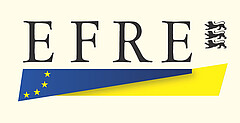REACT-EU recovery assistance: funding amounting to EUR 2.6 million for the University of Hohenheim [04.11.21]
To gain increased insight into the complex interactions in climate-stressed agricultural systems by means of state-of-the-art visualization technology – and to derive concrete recommendations for action for policy makers and society: This is the common goal of the interdisciplinary research network BioInterAct of the Universities of Hohenheim and Tübingen and the Stuttgart State Museum of Natural History. Thanks to EU funding from the ERDF amounting to EUR 2.6 million, it is now possible to purchase a high-performance imaging equipment pool and a functionally coupled isotope mass spectrometer. The new research infrastructure is operated by the Core Facility Hohenheim. The current call for proposals of the ERDF program by the Ministry of Science, Research and the Arts Baden-Württemberg was made possible by increased funding from the REACT-EU recovery assistance program. The funds will be used to tackle the consequences of the pandemic and contribute to the climate-friendly, digital, and stable post-crisis recovery of the economy.
Soil health, plant development and adaptation to changing nutrient situations and ever-more-frequent weather extremes, as well as the diversity of insect species and their interactions with plants and soil constitute a very complex network. In addition, it is directly exposed to the consequences of climate change and other environmental factors.
In order to better understand the complex interactions in climate-stressed ecosystems and to support the development of sustainable systems for future-centric agriculture in times of climate change, the Universities of Hohenheim and Tübingen and the Stuttgar State Museum of Natural History have pooled their expertise in an interdisciplinary consortium.
The collaborative research approach focuses on visualizing the interactions between plants, insects, and soils. To do this, it is necessary to characterize the same object of study in terms of space and time on a wide variety of scales (meters to nanometers) using different imaging analysis techniques.
With EU funding of EUR 2.6 million from the ERDF, the University of Hohenheim can now add five urgently needed large pieces of equipment to its Core Facility:
- a confocal super resolution microscope
- a confocal laser scanning microscope
- a Raman microscope
- an environmental scanning electron microscope
- an isotope ratio mass spectrometer
The new research infrastructure is operated by the Core Facility Hohenheim and can thus be used by all working groups of the University of Hohenheim as well as its cooperation partners.
Background ERDF
The European Regional Development Fund (ERDF) is an EU structural fund that helps to promote economic, territorial, and societal cohesion within the EU.Baden-Württemberg's ERDF program focuses on the leitmotif of "innovation and energy transition" and specifically supports the topics of research and innovation as well as the reduction of CO₂ emissions.
Heavyweights of research
The series “Heavyweights of Research" presents outstanding research projects with a financial volume of at least 350,000 euros for research requiring equipment or 150,000 euros for research without specialized equipment.

